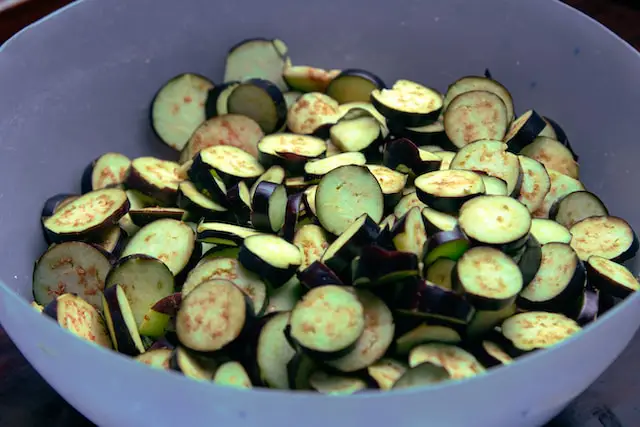Eggplant and Brinjal are two names for the same fruit, Solanum melongena. While they may have different names in various parts of the world, their characteristics and nutritional values remain consistent.
TL;DR Eggplant Vs. Brinjal
Eggplant and brinjal are the same fruit, scientifically known as Solanum melongena, but they are known by different names in various parts of the world. In North America and Australia, it’s called “eggplant,” while in South Asia and British English-speaking countries, it’s known as “brinjal.” Despite the name differences, their characteristics and nutritional values remain consistent. Both are low in calories and rich in essential nutrients, including fiber, vitamins C, K, B6, and folate, as well as minerals like potassium and magnesium. Eggplant/brinjal can be prepared through various cooking methods such as roasting, grilling, stir-frying, sautéing, and can be used in dishes like stuffed eggplant or brinjal curry. It’s a versatile and healthy addition to any balanced diet.
Eggplant Vs. Brinjal – Are they different?

Eggplant vs. Brinjal – a battle of names that has left many confused. Are they truly different or just two sides of the same vegetable coin? Let’s dive in and find out!
To put it simply, eggplant and brinjal are indeed the same fruit, scientifically known as Solanum melongena. However, their names can vary depending on where you are in the world. In North America and Australia, it’s generally called “eggplant,” while in South Asia and British English-speaking countries, it goes by “brinjal.” So really, it all comes down to regional preferences.
There may be slight variations in appearance between eggplant varieties grown in different regions. Some might have a round shape with vibrant purple skin, while others could be elongated with shades ranging from deep purple to light green or even striped patterns. These differences are purely aesthetic; their taste remains consistent throughout.
When it comes to flavor and texture, both eggplants and brinjals offer a mild bitterness that pairs well with various spices and sauces. They have a spongy yet creamy flesh that becomes tender when cooked – perfect for soaking up flavors like a culinary sponge!
Other names for eggplant and brinjal
Eggplant (Solanum melongena) and brinjal are two names for the same vegetable, known by different names in different regions of the world. Here are some other names for eggplant and brinjal:
- Aubergine: This is the common name used in many countries, especially in European and British English. It is widely used in the United Kingdom, France, and other European countries.
- Melanzana: This name is used in Italy and some other Mediterranean countries.
- Baingan: This name is commonly used in South Asia, including India, Pakistan, and Bangladesh.
- Garden Egg: In parts of Africa, eggplant is referred to as “garden egg.”
- Guinea Squash: This name is used in some regions of the Caribbean.
- Beringela: In Brazil and Portugal, “beringela” is the name for eggplant.
- Brinjal or Brinjaul: These are alternative spellings used in various regions.
Nutrition values of eggplant and brinjal
Here are the approximate nutrition values for a 100-gram serving of raw eggplant/brinjal:
- Calories: 25 kcal
- Carbohydrates: 5.88 grams
- Dietary Fiber: 3 grams
- Sugars: 3.53 grams
- Protein: 0.98 grams
- Fat: 0.18 grams
- Vitamin C: 2.2 milligrams (3.7% of the Daily Value – DV)
- Vitamin K: 3.5 micrograms (4.4% DV)
- Vitamin B6: 0.08 milligrams (4% DV)
- Folate: 22 micrograms (5.5% DV)
- Potassium: 229 milligrams (6.2% DV)
- Magnesium: 14 milligrams (3.5% DV)
Eggplant is a good source of dietary fiber, which aids in digestion and helps maintain a healthy gut. It also provides various vitamins and minerals, including vitamin C, vitamin K, vitamin B6, folate, potassium, and magnesium, which contribute to overall health and wellbeing.
It’s important to note that the nutritional values may vary slightly depending on the variety of eggplant and brinjal, as well as how they are prepared (cooked, roasted, fried, etc.). Nevertheless, eggplant/brinjal is a healthy addition to a balanced diet, providing a range of nutrients with relatively low calories.
How to cook eggplant and brinjal?

Roasting/Baking
- Cut the eggplant/brinjal into slices or cubes.
- Toss with olive oil, salt, and pepper.
- Spread the pieces on a baking sheet and roast in a preheated oven at 400°F
- (200°C) until tender and slightly browned.
Grilling
- Slice the eggplant/brinjal into thick rounds.
- Brush both sides with olive oil and season with salt and pepper.
- Grill the slices on a hot grill until they have grill marks and are cooked through.
Stir-frying
- Cut the eggplant/brinjal into bite-sized pieces.
- Heat oil in a wok or frying pan and add the eggplant/brinjal.
- Stir-fry with your choice of vegetables, sauces, and seasonings until tender.
Sautéing
- Cut the eggplant/brinjal into small cubes or slices.
- Heat oil in a pan and add the eggplant/brinjal.
- Sauté until they become soft and slightly browned.
Stuffed Eggplant/Brinjal
- Cut the eggplant/brinjal in half lengthwise and scoop out some flesh to create a cavity.
- Fill the cavity with a mixture of cooked rice, herbs, spices, and other ingredients of your choice.
- Bake the stuffed eggplant/brinjal until tender and the filling is cooked.
Eggplant/Brinjal Curry
- Cut the eggplant/brinjal into chunks or slices.
- Prepare a curry sauce with onions, tomatoes, ginger, garlic, and spices.
- Add the eggplant/brinjal to the curry sauce and cook until tender and flavorful.
Remember to wash the eggplant/brinjal thoroughly before cooking and remove any green parts or stems. Additionally, some recipes may call for salting the eggplant/brinjal slices before cooking to draw out excess moisture and improve their texture. However, modern varieties of eggplant/brinjal are less bitter, so salting is not always necessary.
Eggplant and brinjal can be used in a variety of dishes, including curries, stews, stir-fries, casseroles, and even as a meat substitute in vegetarian dishes. Experiment with different cooking methods and recipes to discover your favorite way to enjoy this delicious vegetable!
Image Credits
Featured Image By – PhotographyCourse on Unsplash
Image 1 By –
Image 2 By – Usman Yousaf on Unsplash









